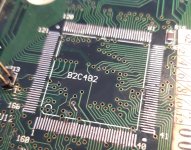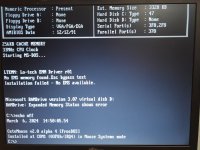Chr$
Experienced Member
Hello.
I have a Gigabyte GA486-US motherboard, which looks exactly like this:
 theretroweb.com
theretroweb.com
Cosmetically it's very nice, there has been no battery leakage, so that's always a good start. With CPU, 4 sticks of RAM and post card plugged in I just get dashes shown and no beeps.
I have of course checked the jumpers to the best of my ability and dumped the AMI BIOS, which also looks normal and has a date of 12/12/1991.
CPU has 5v and 33.33mhz clock signal.
Reset starts high and goes low as normal.
I have a basic oscilloscope and noob-class knowledge on these matters. I've prodded the address and data lines on the ISA bus and get the following:
All data lines are stuck high (4.88v, which is the same as what the PSU puts out as 5v as measured on the power connector).
A18, A17 and A29 are all stuck at 0v.
All of the other address lines are stuck at 3.6v.
Next to the ISA slots there are a number of 74(x)245 and 74(x)244 as well as a 74F373. I have identified 5 chips that have connections to the data and address pins on the ISA slots.
Is it a good idea to change those 5? Should I concentrate on the buffer chips with connections to the lines that are stuck low first? I'd love to hear how others would go about further troubleshooting and am grateful for any tips.
(I've attached the BIOS dump to this post as I am not a member on Retroweb and in case anyone would like to add it to the 486US resource)
I have a Gigabyte GA486-US motherboard, which looks exactly like this:
Gigabyte GA-486US
Gigabyte GA-486US is a motherboard based on the UMC UM82C480 (386/486 PC Chip Set) chipset. Get specs, BIOS, documentation and more!
Cosmetically it's very nice, there has been no battery leakage, so that's always a good start. With CPU, 4 sticks of RAM and post card plugged in I just get dashes shown and no beeps.
I have of course checked the jumpers to the best of my ability and dumped the AMI BIOS, which also looks normal and has a date of 12/12/1991.
CPU has 5v and 33.33mhz clock signal.
Reset starts high and goes low as normal.
I have a basic oscilloscope and noob-class knowledge on these matters. I've prodded the address and data lines on the ISA bus and get the following:
All data lines are stuck high (4.88v, which is the same as what the PSU puts out as 5v as measured on the power connector).
A18, A17 and A29 are all stuck at 0v.
All of the other address lines are stuck at 3.6v.
Next to the ISA slots there are a number of 74(x)245 and 74(x)244 as well as a 74F373. I have identified 5 chips that have connections to the data and address pins on the ISA slots.
Is it a good idea to change those 5? Should I concentrate on the buffer chips with connections to the lines that are stuck low first? I'd love to hear how others would go about further troubleshooting and am grateful for any tips.
(I've attached the BIOS dump to this post as I am not a member on Retroweb and in case anyone would like to add it to the 486US resource)


